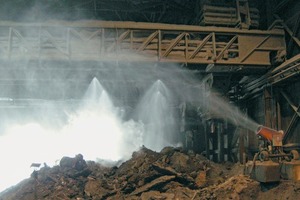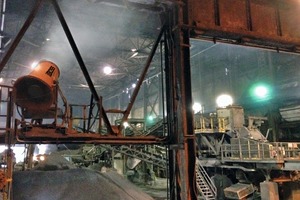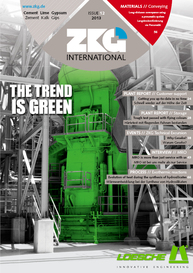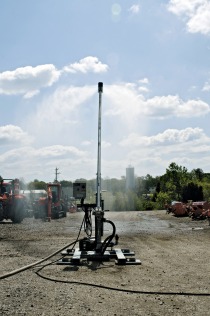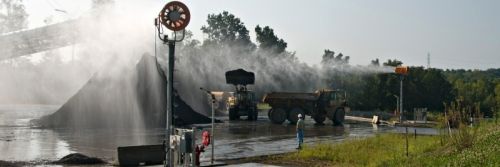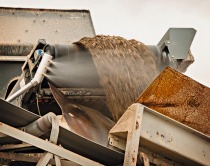High-performance dust suppression
“We knew when we drafted our proposal that environmental responsibility was going to be a primary issue, and this customer stressed both the company’s own code of conduct and the level of stewardship that would be required from us,” observed a member of the management team. “So dust suppression was a priority right from the beginning.”
One of the staff members recalled a successful trial that had been done with DustBoss equipment to successfully manage fugitive material at another of the firm’s locations, and the team decided to see the machines in action. In fact, the company had rented three machines of different sizes from Dust Control Technology (Peoria, IL/USA) for several months, traveling to company locations across the country and evaluating their effectiveness. Convinced that the technology would effectively contain dust at the Washington plant, the group contacted DCT and arranged a site visit.
At this location, two furnaces discharge slag into pits beneath each one, and operations personnel use a front loader to dig and haul the slag to the cooling area. Once the slag reaches a manageable temperature (around 1000°F), it’s processed to remove recoverable metallics and sized into various products for a range of construction applications, as determined by local market needs. The company has specialized in the handling, processing and marketing of slag products for nearly 100 years, currently recycling more than 10 million tons per year company-wide.
“With this mill’s production schedule, the slag must be processed continuously, so it doesn’t build up,” the manager explained. “We’re constantly transporting, crushing and removing it from the property, and it was a part of our contract that we would do so without allowing the dust to escape.”
The network that was developed for this location consists of three DustBoss machines, including one model DB-60 built to handle large applications, with a throw of more than 200 feet. The rugged design is capable of blanketing as much as 280 000 square feet of area with 50-200 micron droplets, the optimum size for effective particle attraction and dust control in most situations.
A series of 30 specially-designed brass nozzles atomize the water, which is then launched by a powerful 25 HP fan that generates 30 000 CFM. Equipped with a 10 HP booster pump to increase water pressure as much as 150 PSI from a 2˝ supply hose, the DB-60 has an adjustable throw angle from 0-50 degrees. The units were mounted on heavy-duty skids for easy transport with a forklift.
Complementing the DB-60’s coverage at the facility are two DB-30s, a smaller design that outperforms its size, capturing dust particles more effectively than many larger machines. The versatile unit has a 7.5 HP motor that generates 9200 CFM. Like its bigger cousin, it features a ring of specially-designed brass nozzles that atomize the water supply to droplets between 50 and 200 microns.
“The 50-200 micron for droplet size is well suited to most applications,” DCT Technical Sales Specialist Carl Harr explained. “But in some cases, the dust particle size may dictate the use of different nozzles or other components to achieve maximum effectiveness. The ability to customize the equipment to specific conditions means we can tailor the solution to the problem.”
The ducted fan design of the DB-30 has an adjustable throw angle from 0-50 degrees elevation and a reach of 100 feet, delivering exceptional coverage of a 30000 square foot area from a standard 5/8˝ garden hose. Because of its compact size, the DB-30 can be an extremely effective option for indoor locations or confined spaces. The machine comes with a 1.5˝ pre-filter with quick cam release for easy access, and it can be set up to run potable or non-potable water.
The three units are strategically placed to deliver full and complete coverage of the raw slag pile, suppressing dust as it is created and preventing it from escaping through the entrances to the bay doors. “The dust suppression network is working well for us, even with all the environmental scrutiny that this location receives,” the manager said. “As a company, we’re always researching new technologies that we can implement to better protect and preserve the land, air and water. The suppression network fits in well with our corporate vision and strategy, and our customers recognize its value.”

